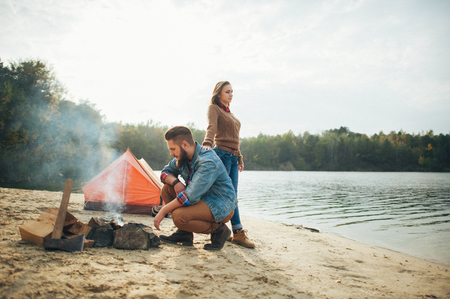Choosing the Right Tent for British Weather
When it comes to camping in Britain, selecting the right tent is the first step towards ensuring a comfortable and safe family adventure. The British climate is famously unpredictable, with sunshine, rain, and gusty winds sometimes all appearing in one day. To prepare for this, it’s important to look for tents that are specifically designed to handle variable weather conditions. Consider waterproof ratings—measured in millimetres (mm)—and opt for a tent with at least 2000mm hydrostatic head to keep everyone dry during those inevitable showers. Wind resistance is just as vital; dome or tunnel tents with sturdy poles and secure guy lines tend to offer better stability on blustery days. Don’t forget ventilation, as well—a tent with good airflow helps prevent condensation build-up, keeping your sleeping bags dry and spirits high. Taking time to choose a tent that matches the demands of the British outdoors means you can focus on making joyful memories, whatever the weather brings.
2. Setting Up on Classic British Terrain
Pitching your tent in Britain often means dealing with a variety of natural surfaces, each with its own quirks and challenges. Whether youre camping in the lush countryside, beside a stony riverbank, or even along a pebbly coast, knowing how to adapt ensures a warm and secure shelter for your family. Let’s explore some practical tips for making any spot feel like home.
Understanding UK Campsite Surfaces
The weather and geography across Britain mean you’ll likely encounter a mix of damp grass, muddy patches, firm earth, or loose pebbles. Each surface requires a slightly different approach to keep your tent upright and comfortable.
Tips for Pitching Your Tent
| Surface Type | Common Issues | Quick Fixes |
|---|---|---|
| Damp Grass | Slippery ground, soggy base | Use a waterproof groundsheet; elevate sleeping mats; double-check pegs are firmly pressed in |
| Muddy Patches | Pegs pulling loose, dirty gear | Choose the driest spot available; use longer pegs; lay down extra tarpaulin under the tent |
| Firm Earth | Difficulty driving in pegs | Bring strong metal pegs; use a mallet; avoid hammering near rocks |
| Pebbly Beaches | Pegs won’t grip, uneven sleeping area | Weigh down tent corners with bags or rocks; use sand/specialist pegs if possible; add extra padding under sleeping area |
Handy Reminders for a Cosy Night
- Check drainage: Avoid pitching at the lowest point where rainwater collects.
- Smooth it out: Remove sharp stones and sticks to protect your tent floor (and your back!).
- Wind direction matters: Face the tent door away from prevailing winds to keep the inside snug.
- Peg security: Always angle pegs away from the tent for better hold—especially important on blustery nights!
No matter which classic British terrain you find yourself on, these little adjustments can make all the difference. With a bit of prep and know-how, you’ll be ready for whatever Mother Nature brings—giving your family peace of mind and plenty of comfort under canvas.
![]()
3. Keeping Your Tent Dry in the Drizzle
Ah, the British drizzle – it’s part and parcel of our camping adventures, isn’t it? While a bit of rain can add to the fun, nobody wants to wake up to soggy sleeping bags or puddles underfoot. Here’s how you can keep your tent snug and dry, even when the heavens open.
Choose the Right Pitch
First things first: where you pitch your tent matters more than you might think. Avoid setting up at the bottom of a slope or in obvious dips where water will naturally collect. Look for slightly elevated ground and check that there are no signs of previous puddling or mud patches. This simple step can save you lots of trouble later on.
Mastering Rainfly and Guy Lines
Your rainfly is your tent’s first line of defence against the British weather. Always ensure it is pulled taut and fully covers all mesh areas of your tent. Don’t forget to peg out those guy lines properly – they help keep the rainfly from touching the inner tent, which is crucial for preventing leaks and promoting airflow.
Tackling Condensation
Even if your tent doesn’t leak, condensation can leave everything feeling damp come morning. To minimise this, always ventilate your tent as much as possible by opening vents or unzipping doors slightly (as long as rain can’t blow in). If it’s safe, leave a small gap at the top for warm air to escape. Using a microfibre towel inside can help mop up any excess moisture overnight.
Practical Waterproofing Solutions
Before you head off on your trip, give your tent an extra layer of protection by applying a waterproofing spray to both the flysheet and seams—especially if your tent has seen a few seasons. Bring along a spare groundsheet or tarp to place under your tent for added reassurance; just make sure it doesn’t poke out from underneath, or it’ll channel water straight under your floor!
Little Helping Hands
If you’re camping with little ones, involve them by giving them their own “jobs” such as checking for drips or helping lay out the groundsheet. Not only does this teach valuable skills, but it also turns a rainy day into a team adventure rather than a washout.
With these tips, that classic British drizzle becomes just another story for the campfire – and everyone stays cosy and dry inside their home-from-home.
Battling British Winds and Gusts
There’s nothing quite like a British breeze—sometimes gentle and refreshing, sometimes a gusty gale that threatens to whisk your tent into the next county. Whether you’re camping in the Lake District or along the blustery Cornish coast, strong winds are a common companion. But don’t worry; with a bit of know-how and the right kit, you can keep your family’s home-from-home safe and snug.
Choosing Reliable Pegs and Guylines
Standard pegs may struggle in soft British soils or against fierce winds. Investing in sturdy, long pegs—such as rock pegs for stony ground or screw-in pegs for sandier pitches—can make all the difference. Pair these with high-visibility, reflective guylines to prevent nighttime trips and ensure everyone’s peace of mind.
| Peg Type | Best For | Wind Resistance |
|---|---|---|
| Rock Pegs | Stony ground, hard soil | Excellent |
| Screw-in Pegs | Sand, loose soil | Very Good |
| Plastic Pegs | Soft grass | Fair |
Securing Your Tent on Exposed Campsites
If you’re pitched up somewhere exposed—like the Yorkshire Moors or Scottish Highlands—it’s crucial to double-check every anchor point. Make sure all guylines are taut but not over-tightened (to avoid tearing fabric), and peg them out at a 45-degree angle from the tent. Consider adding extra guy ropes if strong winds are forecast; most tents have additional loops for this purpose.
Family Tip: Make It a Team Effort!
Turn securing the tent into a fun family task. Let little ones help count out pegs or hold guylines steady while adults hammer them in. Not only does it speed things up, but it also gives everyone a sense of responsibility—and adventure!
5. Dealing with Mud and Mucky Boots
After a family ramble through the British countryside, it’s almost guaranteed that someone will return to camp with muddy boots or soggy socks. But don’t let a bit of muck spoil the fun or make your tent uncomfortable! Here are some simple, family-friendly strategies for keeping mud at bay and making your tent a cosy haven after a wet walk.
Establish a Boot-Off Zone
Before anyone steps inside, set up a designated “boot-off” area just outside your tent entrance. A waterproof mat or even an old towel works wonders here. Encourage everyone—big and small—to leave their boots and wellies here before heading in. This not only keeps mud out but also helps everyone form good camping habits.
Use Shoe Bags or Boxes
Keep a couple of sturdy plastic boxes or washable bags by the tent door for storing wet footwear. This stops drips and dirt from making their way onto your sleeping mats, and it’s easy for little ones to pop their shoes away when they see everyone else doing it too!
Pack Extra Socks and Towels
Muddy adventures often mean damp feet, so pack plenty of spare socks and small towels. After removing boots, give little toes a quick dry and change into fresh socks—it feels like a treat after a chilly walk and keeps spirits high.
Lay Down Protective Ground Sheets
Inside the entrance, use an extra groundsheet or blanket as a buffer zone. It catches stray mud and is easy to shake out each morning. For extra reassurance, pick up an inexpensive doormat from a local shop before you set off—very British!
Make Cleaning Up Fun
Turn muddy boot duty into a game: who can get their shoes the cleanest with just a stick and some water? When everyone joins in, tidying up becomes less of a chore and more of a giggle-filled moment together.
End the Day Cosy
After cleaning up, snuggle in with warm drinks and share stories about your day’s adventure. By keeping the tent mud-free, you’re ensuring everyone has a comfortable space to relax—and you’ll all be ready for another day of exploring Britain’s beautiful outdoors!
6. How to Handle Pesky British Wildlife
When you’re camping in the British countryside, it’s not just the weather you need to prepare for—sometimes our furry neighbours want to join the adventure too! Whether it’s a curious fox or a cheeky squirrel, these creatures can make their way into your campsite, especially if there are tempting treats around. Here are some gentle tips to keep your snacks safe and enjoy nature peacefully as a family:
Keep Food Tidy and Sealed
Foxes and squirrels have an incredible sense of smell, so it’s best to store all your food in airtight containers or zipped cool bags. Remind the kids to pop berry snacks and biscuits away after eating, and never leave leftovers out overnight.
Set Up a Creature-Free Zone
Show little ones how to zip up the tent doors properly, making sure no sneaky paws get inside. You might even make it a fun bedtime routine together—everyone checks their zips before snuggling down for the night!
Gentle Deterrents for Curious Critters
If you spot wildlife nearby, admire them from afar but don’t feed them. Teach children that wild animals need to find their own food. You can scatter citrus peels or use natural scents like peppermint oil around your tent (but always check these are safe for local habitats) as a friendly way to say “no thank you” to visitors.
Rubbish Goes Straight Into Bins
Make cleaning up part of your family fun—race to see who can tidy fastest! Place rubbish straight into campsite bins or take it home if none are available. This keeps animals—and your tent—safe and sound.
Share Wild Tales (Not Snacks)
At bedtime, swap stories about the animals you’ve seen instead of sharing snacks with them. It’s a lovely way to celebrate Britain’s wonderful wildlife while keeping everyone (and every treat) protected on your camping adventure.
7. Quick Fixes for Tent Emergencies
When youre out camping in the wild British countryside, little tent mishaps can quickly put a damper on your adventure. But don’t worry—many common problems like broken zips, torn fabric, or bent poles can be temporarily fixed with a bit of creativity and some handy supplies from your kit. Here’s how you can keep everyone cosy and safe until you’re back home for proper repairs.
Mending Broken Zips
If your tent zip gets stuck or splits open, try gently running a graphite pencil along the teeth to help it glide more smoothly. For zips that won’t close, carefully squeeze the slider with a pair of pliers (or even a sturdy spoon) to tighten its grip. In a pinch, use safety pins or clothes pegs to temporarily secure the door shut—just make sure little fingers stay clear!
Repairing Torn Fabric
A sudden gust of wind on a blustery British evening can sometimes leave you with a rip in your tent. Clear duct tape is your best friend here: press the edges of the tear together and stick tape firmly on both sides, smoothing out any bubbles. If you’ve got a sewing kit handy, a quick running stitch will hold until you can patch it properly at home. For peace of mind when camping with children, always pack some extra fabric patches—they’re small but mighty.
Straightening Bent Poles
Bent or snapped poles are no match for resourceful campers! Gently bend any minor kinks back into place using both hands and steady pressure. For more serious breaks, wrap the pole tightly with duct tape or lash it with string, then slide a sturdy stick alongside as a splint. Just remind everyone to avoid putting too much pressure on the repaired section.
Essential Emergency Supplies
Before heading off on your next family camping trip in Britain, pack these essentials: strong duct tape, safety pins, spare guy lines, fabric patches, a small sewing kit, and some cable ties. These simple items can turn an “oh no!” moment into an empowering family memory—and teach little campers about problem-solving in the great outdoors.
Keeping Calm Together
Remember, even when things go wrong under canvas, staying calm and working as a team can transform tent troubles into stories you’ll all laugh about later. With these quick fixes up your sleeve, you’ll be ready to face whatever British weather throws your way—together.


